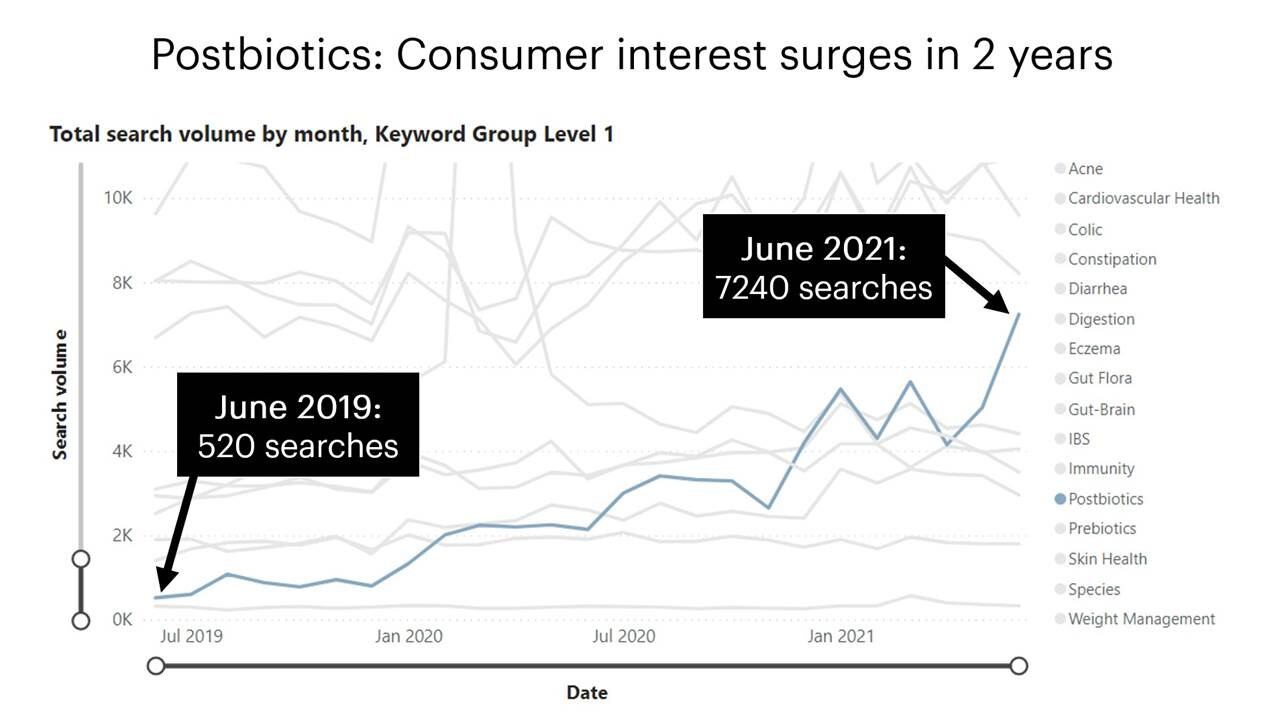The market insights firm has added 26 new keywords to its Microbiome Search Trends Dashboard pertaining to searches for ‘postbiotics’ and these additions reveal searches grew from 520 in June 2019, to 7240 in June this year.
“This is a really exciting emerging group of keywords as in just two years it has gone from pretty much zero interest to having equal interest to bigger groups such as cardiovascular health and immunity,” says Zoe Coleman, digital marketing manager at Lumina.

Investigating the cause of this heightened interest, Coleman says that it is helpful to look at the level of press coverage that has been given to the topic, as this indicates the level of exposure consumers have had.
“Using BuzzSumo, we can see the number of articles that have been published on any particular topic. Looking at ‘postbiotics’ we can see that over the course of two years, there have been a mounting number of articles.
“In July 2019, there were a negligible number of articles on this topic, whereas by 2021 we see 40 or so articles published every month with many of these appearing in mainstream media such as Woman’s World and Runner’s World, with many driving a good amount of Facebook engagement too which, in a niche area such as postbiotics, is quite exciting.”
Turning to Google Trends data, Coleman says the number of searches for postbiotics have grown in tandem with the growing press coverage.
“Between June 2020 and June 2021, searches grew by nearly 240%. Although that was starting from a low base, if we look at the search volume in June this year, we can see the actual growth over the last year was 5100 searches which is comparable to constipation which had an average year-on-year change of just over 6000 searches, and that is one of the high growth and high search groups.”
Looking at the exact phrases being searched, it is clear that much of the search volume is coming from consumers looking into specific formats of postbiotics, with phrases such as ‘postbiotics supplements’, ‘postbiotic foods’, and ‘postbiotic powder’ regularly searched.
There have also been a significant number of searches from consumers looking to understand the very basics about these ingredients with questions such as ‘what are postbiotics?’, ‘what are the benefits of postbiotics?’, ‘postbiotic definition’, and ‘best postbiotics’.
Coleman does point out that the number of ‘postbiotics supplements’ searches in June 2021 was a bit ‘fishy’ in that it was very sudden and extreme growth for just one keyword, which may mean this was just a spike in the data caused by a trending article or such like. However, the YOY increase for the postbiotics category between May 2020 – May 2021 was still 124% and the two year (May 2019 – May 2021) was still 815%.
“Even outside of this weird June 2021 spike this is a category experiencing a tremendous increase in interest from consumers,” she says.
“It’s also interesting to see a lot of consumers are clearly trying to understand and compare the difference between postbiotics and pro and prebiotics. There are a number of searches looking to compare the three groups and that’s particularly interesting as it’s not something we see when looking at prebiotic searches.
“Although I would say consumers’ search phrases suggest they are in the early adopter stage of research – the dominant keyword in this group “postbiotic supplements” does specify the format, which implies a level of commercial intent. Likewise, searches for ‘postbiotic foods’ also demonstrates a stronger ‘ready to buy’ signal.
“In terms of how firms could help consumers get over the line – from initial research to purchase intent - the key is to provide the information they are looking for with evidence showing benefits of their own products and clear directions as to where consumers can buy them. So – what are postbiotics, what do they do, how are they different to pre and pro biotics, what evidence is there that they work, where and in what formats can you find them.”


